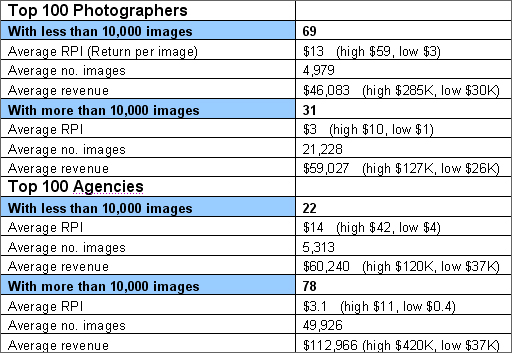.jpg) This topic is by definition outside the sphere of microstock; none the less it's a question that most microstock photographers will ask themselves sooner or later...
This topic is by definition outside the sphere of microstock; none the less it's a question that most microstock photographers will ask themselves sooner or later...
All microstock images are RF (royalty free), but is there more money in selling your images RM? (rights managed). (read an overview of stock photo licensing terms)
This question is a difficult one to answer, similar to the exclusive or not exclusive question. One thing is for sure you can only sell an image as either RM or RF, the same image can't be sold in both licensing models. It's also unwise to sell images from the same series (similars) under differing licenses. RM buyers might be paying for images to be exclusive to their industry or across-the-board, they would not be happy to see a similar looking image spread across all microstock sites for a few dollars.
Which images work best as RM
RM images are often a lot more 'trendy' or stylised than microstock, this is one of the things that makes RM agencies still an attractive place to buy even if the price is more expensive and the licensing more time consuming.
It's perhaps easier to define what won't sell so well; you might find that textures like brick walls or metal sheets are downloaded frequently on shutterstock but these generic images are unlikely to be the type of subject that can command an RM price tag. RM agencies do sell 'apple on a white background' for $400 but it's not the norm, especially as more buyers realise that such 'style less' generic images can be found easily as microstock.
Specialist images which sell infrequently and are hard to find are definitely something you should consider as rights managed, e.g. science, medical, difficult subjects for example birds (wild birds not run-of-the-mill garden birds), anything that needs a specialist set-up or knowledge that the average photographer can't shoot can demand an RM license. Buyers choose RM images for several reasons but one of them is that they offer more diverse range of images over microstock and full priced RF.
Where to sell RM
 Almost all of the big stock photography agencies sell some or all of their images as RM, but these agencies were and still are difficult to get started with for those new to stock photography (<5 years), especially for those coming from a microstock or part-time background.
Almost all of the big stock photography agencies sell some or all of their images as RM, but these agencies were and still are difficult to get started with for those new to stock photography (<5 years), especially for those coming from a microstock or part-time background.
Armed with a copy of fotoquote you could work out suitable prices yourself, again probably not the type of thing that most of you will be interested in doing.
There are several sites that allow uploads (some for a fee) and then license your images as RM, the only site I'm going recommend for selling RM is Alamy, Why?
- There is no hosting or setup fee.
- You can sell as little or as much as you like and continue selling other images as microstock.
- They have been around 'forever' and seem unlikely to close.
- Offers 50+ million images so buyers know they can find the most esoteric subjects.
- If technically good they won't criticise or reject all your work; if it's bad, it just won't sell and will reduce sales of other images you have with Alamy (your Alamy rank).
Alamy operates much like a microstock site, images are ranked with their own proprietary technology, so despite the fact that you can upload anything that was taken with a decent camera it's still best practice to only upload 'good, well composed images'. On Alamy it's the buyers who choose with their mouse clicks which images are best not an image inspector making rejections like 'not what we are looking for'.
It's certainly not unusual for a microstock contributor to also be selling some of their work on Alamy, the difficult questions are based around which images to sell on there. Initially Alamy accepted only images shot on film and you needed to post images on CD. These days you can upload digital but images but they must be 48mb or larger (so in most cases you need to up-size images from a DSLR), needless to say full details of the process are on their site.
If you prefer to sell images direct to clients and cut out the agency then have a look at why not sell images direct, to read more about some of the pitfalls of going it alone.
Alamy has a long tail too
Some interesting reading on the Alamy blog revealed that alamy sales are like microstock, they sell 'less of more'. This is long tail in the Chris Anderson sense, in microstock longtail can also be used to describe the way that after upload images may sell well for several weeks then tail off drastically but in doing so still earn more overall i.e. selling less frequently over a longer time period).
The following figures were originally posted on the Alamy blog in 2009 Alamy blog link (content now removed), they list the average earnings for their top 100 photographers and agencies. As can be seen those with more images on Alamy earn a higher return overall. Looking at the photographers only you can the difference is not that great 46k to 59k and with the amount of images involved then uploading and keywording would become a significant factor.
Related Posts
Introduction to Licensing Images




It's quiet in here! Add new comment